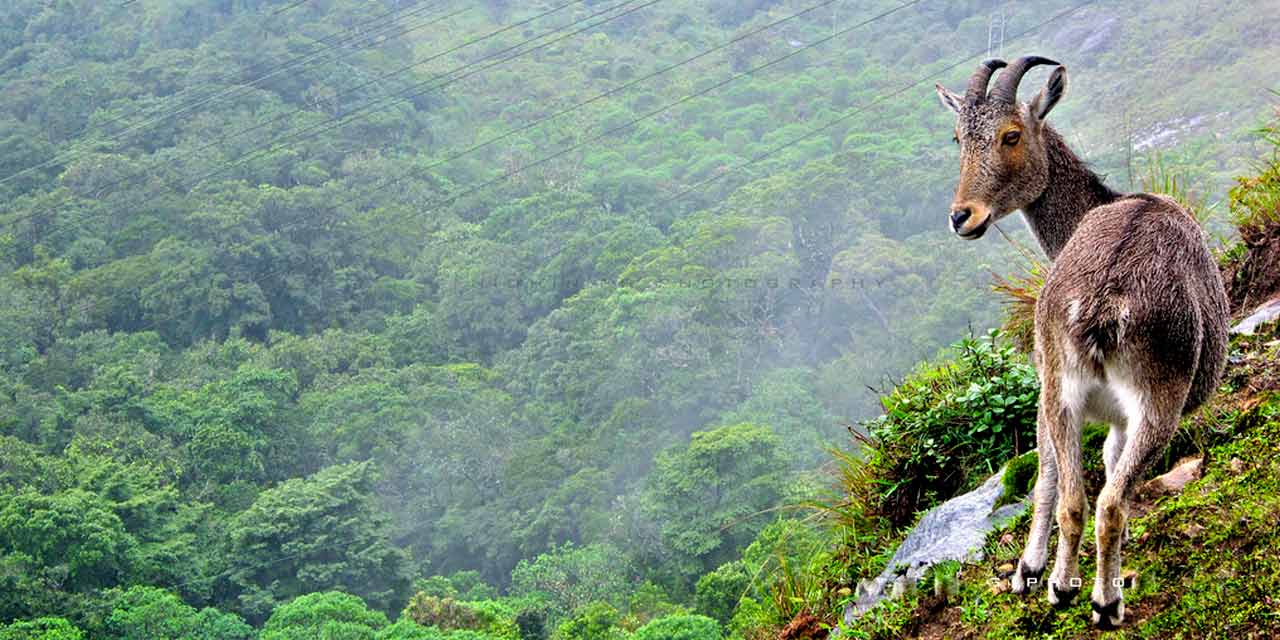About Eravikulam National Park
- Location: It is located along the Western Ghats in the Idukki district of Kerala.
- It was declared as National Park in 1978.
- The Park covers an area of 97 sq.km.
- The highest peak south of the Himalayas, the Anamudi (2695 meters), is situated on the southern side of the park.
- This is also the land of “Neelakurinji”, the flower that blooms once every twelve years.
- Climate: The park receives heavy showers during the southwest (June/July) and retreating (October/November) monsoons and is one of the wettest areas of the world.
- Vegetation: The major part of the park is covered with rolling grasslands, but several patches of shola forests are also found in the upper part of the valley.
- Flora:
- Important flora includes Actinodaphne bourdilloni, Microtropis ramiflora, Pittosporum tetraspermium, Sysygium aronottianum, Chrysopogon Zelanieus, etc.
- The shola grasslands are exceptionally rich in balsams and orchids, including the long thought extinct variety Brachycorythis wightii.
- Fauna:
- The Nilgiri Tahr, Gaur, Sloth Bear, Nilgiri Langur, Tiger, Leopard, Giant Squirrel, and wild dog are the common species.
- Half the world population of the endangered Nilgiri Tahr lives here.
- The Atlas moth, the largest of its kind in the world, is seen in this park.
- 140 species of birds, of which 10 are unique to the Western Ghats. More than 100 varieties of butterflies have been recorded here.
Key Facts about Nilgiri tahr
- It is an endangered mountain ungulate endemic to the southern part of the Western Ghats.
- Scientific Name: Nilgiritragus hylocrius
- Locally, the animal is called ‘Varayaadu’.
- They are known for their gravity-defying skills in climbing steep cliffs, earning them the nickname Mountain Monarch.
- It is the state animal of Tamil Nadu.
- Distribution:
- Their present distribution is limited to approximately 5% of the Western Ghats in southern India (Kerala and Tamil Nadu).
- Eravikulam National Park in Kerala has the highest density and largest surviving population of Nilgiri tahr.
- Habitat: They inhabit the open montane grassland habitats at elevations from 1200 to 2600 m of the South Western Ghats.
- Features:
- It has a stocky body with short, coarse fur and a bristly mane.
- Both sexes have curved horns, which are larger in the males, reaching up to 40 cm in males and 30 cm in females.
- Adult males develop a light grey area or ’saddle’ on their backs and are hence called ‘saddlebacks’.
- It has a short grey-brown or dark coat.
- Conservation Status:
- IUCN Red List: Endangered
- Wildlife (Protection) Act of India, 1972: Schedule I
Q1) What are shola forests?
The Shola forests of South India derive their name from the Tamil word solai, which means a ‘tropical rainforest’. Classified as ‘Southern Montane Wet Temperate Forest’, the Sholas are found in the upper reaches of the Nilgiris, Anamalais, Palni hills, Kalakadu, Mundanthurai and Kanyakumari in the states of Tamil Nadu and Kerala.These forests are found sheltered in valleys with sufficient moisture and proper drainage, at an altitude of more than 1,500 metres. The upper reaches are covered with grasslands, known as Shola grasslands. The vegetation that grows in Shola forests is evergreen.
Source: Eravikulam National Park to be shut from February 1 for calving season of Nilgiri tahr
Last updated on June, 2025
→ UPSC Notification 2025 was released on 22nd January 2025.
→ UPSC Prelims Result 2025 is out now for the CSE held on 25 May 2025.
→ UPSC Prelims Question Paper 2025 and Unofficial Prelims Answer Key 2025 are available now.
→ UPSC Calendar 2026 is released on 15th May, 2025.
→ The UPSC Vacancy 2025 were released 1129, out of which 979 were for UPSC CSE and remaining 150 are for UPSC IFoS.
→ UPSC Mains 2025 will be conducted on 22nd August 2025.
→ UPSC Prelims 2026 will be conducted on 24th May, 2026 & UPSC Mains 2026 will be conducted on 21st August 2026.
→ The UPSC Selection Process is of 3 stages-Prelims, Mains and Interview.
→ UPSC Result 2024 is released with latest UPSC Marksheet 2024. Check Now!
→ UPSC Toppers List 2024 is released now. Shakti Dubey is UPSC AIR 1 2024 Topper.
→ Also check Best IAS Coaching in Delhi
























